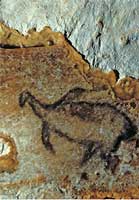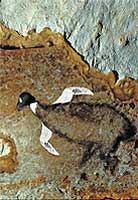 Plate 17 Plate 17
|
 Plate 18 Plate 18
|
|
cave’s elevation lies in climate change that affected sea level. In fact, the series of climate changes that have taken place over the past 30,000 years have shifted the location of the cave entrance from above to below sea level and back again. Researchers have taken samples from charcoal drawings in the cave for radiocarbon dating. These tests apparently confirmed two major production phases: one about 27,000 years ago, when finger tracings (by the thousands) and stenciled hands (at least 55) were created; and a second phase between 18,000 and 19,000 years ago, when most of the animals, including this one, were completed.[33] The second production phase came shortly after the last glacial maximum, when much of the Earth’s water was tied up in great ice sheets, and sea levels were lower than today’s by 300 feet (90 meters) or more. The cave’s entrance would have been high and dry at that time, but progressive warming over the past 10,000 years--during the Holocene period--eventually immersed the entrance.
The depictions of marine life in Cosquer Cave provide an indication of the possible value of particular organisms to our forebears. For example, numerous seals are shown, often speared. Evidence of hunting is not limited to seals--28 percent of the animal images include arrows or
page 3--> |
Plate 17 Auk in Cosquer Cave,Alpes Maritimes, France, c. 17,000-16,000 BCE. Charcoal on rock wall. © Photo: J. Clottes. In J. Clottes, J. Courtin, and L. Vanrell, Cosquer Redécouvert (Paris: Le Seuil, 2005). Science Art--Birds.
Plate 18 Modified Detail of Auk in Cosquer Cave,Alpes Maritimes, France, 2005/2007, by Darryl Wheye. © Darryl Wheye. Science Art-Birds
© 2008 Darryl Wheye and Donald Kennedy
|

 Plate 17
Plate 17  Plate 18
Plate 18